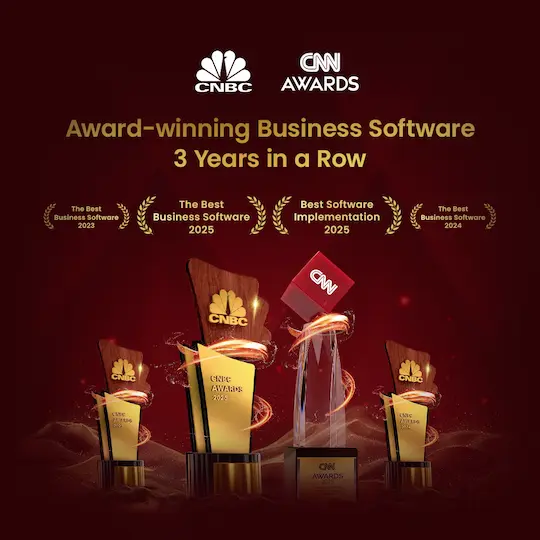Effective inventory management offers benefits such as smoother operations and better control over stock levels, making it essential for almost every industry that produces or sells physical goods.
One of the biggest challenges caused by poor inventory control is stockouts. According to Shopify, global retailers lose over USD 1 trillion annually due to stockouts. It highlights the criticality of proper inventory management.
In this article, we will explore the key advantages of implementing an inventory management system, especially when integrated with an ERP solution. To understand how the system can improve your operations, feel free to request our free demo.
Table of Contents

Key Takeaways
|
What is Inventory Management?
Inventory management is the process of organizing, monitoring, and controlling the flow of goods within a business to ensure the right products are available at the right time and in the right quantities. It includes tracking stock levels and forecasting future needs using historical data and market trends.
Effective inventory management is essential for improving efficiency and increasing customer satisfaction. Whether for small businesses or large enterprises, adopting inventory management AI supports better decision-making and long-term growth.
“Inventory management is the disciplined process of controlling stock levels and product movement so businesses can meet demand efficiently, minimize waste, and protect profitability.”
— Angela Tan, Regional Manager
Type of Inventory Management System
Choosing the right inventory management system is essential for businesses aiming to streamline operations and reduce costs. Different systems cater to varying needs, from managing production schedules to optimizing stock levels.
Understanding these types will help you identify the best approach to improve efficiency and achieve your business goals.
1. Just-in-Time Management (JIT)
The Just-in-Time (JIT) inventory management system minimizes inventory levels by ordering goods only as needed. This approach reduces storage costs and waste while ensuring businesses operate efficiently, but it requires precise coordination with suppliers to meet demand promptly.
2. Materials Requirement Planning (MRP)
Materials Requirement Planning (MRP) focuses on ensuring that materials and components are available for production while keeping inventory levels as low as possible. By relying on sales forecasts and production schedules, MRP helps businesses streamline operations, reduce excess inventory, and avoid manufacturing delays.
3. Economic Order Quantity (EOQ)
The Economic Order Quantity (EOQ) model is designed to determine the optimal order quantity that minimizes total inventory costs, including ordering and holding expenses. This method ensures businesses maintain sufficient stock levels to meet customer demand without overspending on storage or procurement.
4. Days Sales of Inventory (DSI)
Days Sales of Inventory (DSI) measures how quickly a business can convert its inventory into sales, providing valuable insights into operational efficiency. By tracking this metric, businesses can identify trends, improve cash flow, and optimize inventory turnover for better financial performance.
These inventory management systems offer unique benefits, and selecting the right one depends on your business’s specific needs and operational goals. Implementing a tailored system ensures efficiency, reduces costs, and enhances overall supply chain performance.
It’s important to remember that the inventory list must be submitted to the Bureau of Internal Revenue (BIR). Ensure that your receipts and invoices meet all inventory list BIR requirements.
Read More: Top Manufacturing Inventory Software
Benefits of Using Inventory Management Software
Using inventory management software is essential to improving stock handling. It helps automate everyday tasks such as economic order quantity and allows users to focus on understanding data to make well-informed decisions.
Integrating inventory management software with an Enterprise Resource Planning (ERP) system provides businesses with a comprehensive platform for managing their operations. This integration offers several key benefits of the inventory management system:
1. Streamlined to increase profit and reduce costs
With inventory management software integrated into an ERP system, businesses can streamline financial workflows by having stock movements automatically update financial records, reducing manual input and the risk of errors.
The system’s built-in analytics also enhance demand forecasting, enabling smarter purchasing decisions and improving inventory turnover. As a result, companies can reduce costs, prevent stock imbalances, and increase overall operational efficiency.
For example, a retail business previously experienced stock inconsistencies, including frequent overstocking and stockouts. After integrating its inventory management with an ERP system, accuracy improved from 70% to 98%.
The upgrade helped reduce storage costs by 25% and boost sales by 15%, thanks to real-time visibility and more responsive inventory planning. In essence, an integrated inventory management system within an ERP helps companies to:
- Reduce costs: By minimizing excess inventory and associated holding costs.
- Increase profit: Through improved order fulfillment, customer satisfaction, and sales.
- Enhance decision-making: With accurate data and predictive analytics for better inventory planning.
2. Automation and efficiency
Integration with an ERP system streamlines inventory operations by automating key tasks and improving overall accuracy. With real-time visibility into stock levels, businesses can minimize the risk of stockouts or excess inventory while making faster.
This integration also enables smoother order fulfilment and more efficient restocking processes. For instance, a wholesale distributor handling large order volumes previously struggled with slow fulfilment and frequent errors due to manual workflows.
After integrating with an ERP system, the company’s operations became significantly more efficient:
- Automated order processing: Orders are sent directly to the warehouse, where they are prepared and packed. The system generates a list of items to pick and determines the best way to collect them, speeding up delivery.
- Automated restocking: The ERP system decides when to reorder each product. It orders more automatically if the amount in stock drops too low, based on the minimum number that has been decided previously. This keeps the stock steady and avoids running out of products.
- Real-time inventory tracking: The system maintains an up-to-the-minute inventory record, ensuring accurate counts and minimizing errors. This automated process leads to more precise financial records and better stock record matching.
- Enhanced decision-making: Having the latest data improves a business plan for restocking products and for storage arrangements. This can cut down expenses and help manage money better by avoiding too much stock
3. Improved supply chain visibility
Integrating inventory management with an ERP system gives businesses complete supply chain visibility, enabling them to track goods from suppliers to customers and quickly spot bottlenecks.
For example, a consumer electronics manufacturer that once struggled with limited oversight and frequent delays can streamline coordination and improve efficiency once ERP-driven supply chain tracking is in place.
After integrating its inventory management software with an ERP system that includes supply chain management software, the manufacturing company experienced significant improvements:
- Comprehensive supply chain visibility: The ERP system gave the company a clear picture of everything from getting materials to delivering products. This complete overview helped find and fix any delays easily.
- Improved collaboration: The system helped different parts of the company and their suppliers talk to each other better. This made sharing information easier, leading to less confusion and more efficient work.
- Enhanced customer satisfaction: The company fixed delays and made the supply process smoother, so they could complete orders faster and more correctly. This made customers happier and more likely to buy again.
4. Better collaboration across department
Another benefit of an inventory management system is that, when integrated into an ERP system, businesses can access all relevant data from a single platform. This centralized approach reduces the need for manual data entry across different systems.
Therefore, choosing the best pharmacy inventory system is a crucial step for business people. Reads reviews or getting more recommendations for cloud inventory management software can help you to make better decisions.
A centralized ERP system also fosters better collaboration across departments. When medical inventory software is integrated with ERP, sales, purchasing, production, and accounting teams can access shared data. This seamless collaboration promotes efficient communication and reduces misalignment between departments.
This scenario changes dramatically with inventory management software integrated into an ERP system. The business can:
- Access centralized data: All stock information is kept in a single system, which allows instant access and reduces the need to enter data by hand.
- Ensure data consistency: The system automatically adjusts the stock numbers when items are sold or restocked, keeping the count the same everywhere.
- Enhance collaboration: A single system lets all departments see the same information, which helps them work together better. For instance, the sales team can see up-to-date stock numbers for all places to give customers correct information.
5. Better customer satisfaction
ERP systems often include Customer Relationship Management (CRM) modules. Integration with inventory management software enables businesses to align inventory with customer needs.
Imagine an e-commerce company specializing in electronic gadgets and accessories. Before integrating its CRM and inventory management software with its ERP system, the company faced several challenges in order processing and customer service.
After integrating CRM and ecommerce inventory management software with the ERP system, the e-commerce company saw substantial improvements:
- Aligned inventory with customer needs: The system links the company’s stock to what customers want, using information from the customer relationship management (CRM) system. This ensured that the best-selling items were always available, lowering the chance of stockouts.
- Efficient order processing: Sales teams could immediately see stock information, which helped them handle orders quickly and correctly. This led to fewer hold-ups and better order completion.
6. Scalability and flexibility
ERP-integrated inventory management systems are designed to scale with business growth. This scalability ensures the system can accommodate increasing inventory demands and adapt to changing business needs without requiring significant system modifications.
Imagine a retail company that started with a single store but has rapidly expanded to multiple locations nationwide. The company used separate systems for each store before integrating its inventory management system with an ERP.
After integrating its inventory management system with a scalable ERP solution, the retail company experienced significant improvements as it continued to grow:
- Unified inventory management: The ERP system enabled the company to handle stock from all places using one main system, giving a full picture of the stock throughout the company.
- Accommodates business expansion: As the company grew and opened more stores, the ERP system easily adjusted to handle more stock without needing big changes to the system.
- Flexible adaptability: The system could grow with the company, helping it adapt to new needs, such as offering different products or selling in new areas. This ability to change helped the company expand smoothly without messing up its current business.
HashMicro stands out as the best ERP inventory management system in the Philippines. With complete modules, businesses can achieve maximum inventory management. To learn more about the system, you can download the price scheme below.
7. Enhanced compliance and regulation
ERP-integrated inventory management software helps businesses comply with industry regulations and standards. The system can track regulatory requirements, such as product labeling and safety standards, reducing non-compliance risk and associated penalties.
Consider a food and beverage company that produces packaged goods. Before integrating its inventory management software with an ERP system, the company faced compliance challenges regarding product labeling and safety standards.
You can also benefit from inventory management with the ERP system integration, the food and beverage company experienced significant improvements in compliance:
- Consistent product labeling: The system lets the company manage all its product labeling rules in one place. It ensures that every label includes the right details, such as ingredients, nutrition facts, and use-by dates, following the industry rules.
- Safety compliance tracking: The ERP system made it easier for the company to monitor safety rules and ensure that all products were safe to use. This helped lower the chance of breaking rules and facing fines.
- Streamlined documentation: The company used one main system to create and track important paperwork automatically. This made getting to and sharing these papers during inspections or checks much simpler.
- Reduced risk of non-compliance: The company tracked rules and ensured labels and safety were always up to standard. This helped them avoid breaking rules, fines, or calling back products.
8. Enhanced reporting and analytics
ERP-integrated inventory management software allows businesses to generate comprehensive reports and analytics. These insights can help businesses analyze trends, forecast demand, and make data-driven decisions about inventory levels and purchasing.
Consider a retail company that sells seasonal products, such as clothing and accessories. Before integrating its inventory management software with an ERP system, the company struggled to predict demand accurately.
After integrating its inventory management software with an ERP system, the retail company experienced significant improvements in demand forecasting and inventory management:
- Comprehensive reports: The ERP system created in-depth reports on sales patterns, stock amounts, and customer behavior. This helped the company understand which products were selling well and which weren’t.
- Accurate demand forecasting: The company used past sales and seasonal patterns to predict how much they would sell. This made managing stock better and helped avoid running out of items when they’re needed the most.
- Enhanced production planning: With improved predictions of future sales, the company could plan its production to match what customers are likely to buy. This helped cut down on unused products and made the company work better.
- Optimized purchasing: The company looked at stock patterns to make smart buying choices, ensuring they ordered the correct products when needed.
Disadvantages of an Inventory Management System
Inventory management systems share common drawbacks with most business software. It can be costly, challenging to master, and vulnerable to technical issues. Fortunately, these risks can be minimized through appropriate preventive measures.
- High costs for small businesses: Inventory management software can be pricey for smaller companies, but the long-term gains often outweigh the initial investment. Many cloud-based options now make advanced tools more affordable.
- Steep learning curve: Some systems require time to master, but this challenge can be eased with proper onboarding and training resources that help teams adapt quickly.
- System downtime risks: Software failures can disrupt operations, yet using reliable cloud-based platforms helps ensure data protection and minimizes downtime.
- Cybersecurity threats: Digital systems can be targeted by hackers, especially as the rise of IoT increases the attack surface. However, reputable cloud providers typically offer stronger security measures.
- Decline in physical stock checks: Heavy reliance on automation may cause teams to overlook manual inventory counts. Regular physical audits solve this issue and help maintain accuracy.
How to Choose an Inventory Management
Choosing the right inventory management system is a crucial step in optimizing your business operations and achieving efficiency. The following steps will guide you in selecting a system that aligns with your goals and supports long-term growth.
1. Assess your business needs: Start by identifying your specific inventory challenges and requirements, such as tracking stock across multiple locations or managing perishable goods. A system that aligns with your unique operational goals will deliver the most value.
2. Look for Scalability: Choose a system that can grow with your business, accommodating increased inventory and more complex operations as you expand. Scalability ensures your investment remains relevant and cost-effective over time.
3. Evaluate features and functionality: Ensure the system includes essential features like real-time tracking and automated reordering. Additional tools, such as barcode scanning or integration with other software, can further enhance efficiency.
4. Check user-friendliness: Opt for a system that is intuitive and easy to navigate, reducing your team’s learning curve. A user-friendly interface increases adoption rates and ensures smooth daily operations.
5. Prioritize integration capabilities: Select a system that integrates seamlessly with your existing software, such as accounting or ERP systems. This ensures streamlined workflows and reduces the risk of data silos.
6. Ensure strong customer support: Reliable customer support is essential for resolving technical issues quickly and minimizing downtime. Look for vendors that offer comprehensive support, including training, troubleshooting, and updates.
7. Consider budget and ROI: Balance your budget with the system’s features and long-term benefits. An effective inventory management solution should provide a strong return on investment by improving efficiency and reducing costs.
Choosing the right inventory management system is crucial for optimizing your operations and staying competitive. By evaluating your needs and aligning them with the system’s capabilities, you can make a confident, informed decision.
Read more: Top Construction Inventory Management Software
HashMicro’s Inventory Management System as Your Business Solution
HashMicro’s Inventory Management System is designed to provide a comprehensive and efficient solution for businesses seeking to improve their inventory management processes. It offers a range of features that help streamline operations, reduce costs, and enhance business efficiency.
Here’s an in-depth look at what makes HashMicro’s system a valuable choice for your business.
- Real-time inventory tracking: This feature lets businesses monitor their stock accurately, enabling them to make informed decisions. With real-time visibility, they can avoid stockouts and overstocking and maintain the right inventory levels.
- Automated inventory control: HashMicro’s inventory control system automates various inventory tasks, such as reordering, stock adjustments, and inventory counts. This reduces manual work, minimizes errors, and speeds up inventory control processes for better efficiency and accuracy.
- Integration with ERP systems: This integration lets businesses centralize their operations, covering inventory management, accounting, and customer relationship management (CRM). A centralized platform improves cross-department collaboration and boosts overall efficiency.
- User-friendly interface: The intuitive design shortens the learning curve, making it easier to adopt and reducing the need for extensive training. This user-friendly approach boosts productivity and ensures a smoother transition to the new system.
- Customization and scalability: The system can be adjusted to fit your needs, whether you need specific workflows, custom reports, or unique features. It’s also designed to grow with your business so that it can scale without major changes or extra costs.
Conclusion
Poor inventory management or manual processes can have far-reaching consequences for a company, affecting its efficiency, costs, cash flow, customer satisfaction, and compliance. Implementing an automated inventory management system can help mitigate these risks and lead to more efficient and effective business operations.
Integrating inventory management software with an ERP system gives businesses centralized data management, automation, real-time tracking, and improved collaboration across departments. This integration enhances efficiency, streamlines financial processes, and supports scalability, helping businesses stay competitive in a dynamic market.
HashMicro’s Inventory Management System offers a comprehensive solution for businesses seeking to improve their inventory management processes. With features like real-time tracking, automation, ERP integration, and advanced reporting, the system provides businesses with the tools to enhance efficiency and support growth.
If you want to learn more, request a free demo from HashMicro to explore the system’s capabilities and see how it can benefit your business.
FAQ about the Benefits of Inventory Management
-
What are the challenges of manual inventory management, and how can they be addressed?
Manual inventory management in the Philippines often faces issues such as inconsistent tracking, inefficient warehouse management, data inaccuracy, limited process visibility, and overstocking problems. These challenges can be addressed by adopting automated inventory management systems with real-time tracking, accurate data entry, and better overall process visibility.
-
How does inventory management software integrate with e-commerce platforms?
Inventory management software can seamlessly integrate with e-commerce platforms like Shopee, Lazada, Amazon, and Shopify. This integration ensures real-time synchronization of inventory levels, automatic updates for stock movements, and efficient handling of sales orders.
-
How can inventory management systems improve warehouse operations?
Inventory management systems enhance warehouse operations by providing real-time data on stock levels, optimizing space utilization, and automating processes like picking, packing, and shipping. These systems also support better product organization through features like barcode scanning and location tracking.
-
What role does data analytics play in inventory management?
Data analytics in inventory management allows businesses to gain insights into sales trends, customer preferences, and inventory turnover rates. By analyzing this data, companies can make informed decisions on stock replenishment, identify slow-moving items, and optimize their inventory levels.
-
What features should businesses look for in inventory management software?
When selecting inventory management software, businesses in the Philippines should look for features such as inventory tracking and control, barcode scanning, multi-location management, integration with e-commerce platforms, and comprehensive reporting and analytics.


























